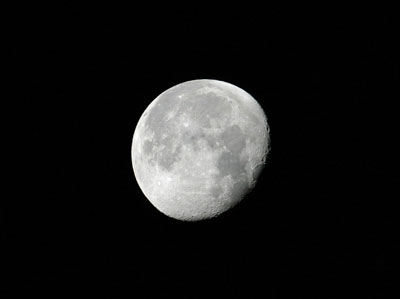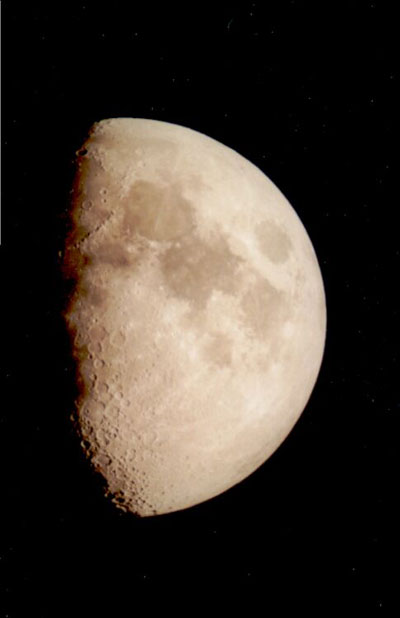The size of the Moon is often overestimated because of its brightness. With a diameter of 0.5°, which is not even equal to the thickness of a thumb if you stretch out your arm, it is still quite small. With the exception of the lunar maria, you can‘t see many details on its surface with the naked eye. With increasing magnification it reveals more and more craters, canyons and ridges. Even with a pair of low magnification binoculars there is a lot to see, although the Moon still appears quite small even at ten times magnification.
Most details show up on the border between the light day side and dark night side of the Moon, the so-called terminator. In this area there is dusk, so the Sun is low over the lunar horizon and the mountains cast long shadows. Where the Sun is higher above the horizon, the shadows are correspondingly shorter, and the contrast is less. The same effect can be easily understood with a carpeted floor and a flashlight – if you light the carpet from above, it appears structure less, whereas in flat light any lint and each height can be clearly seen. Therefore full Moon nights are the most boring nights from astronomical point of view – on the one hand, the full Moon outshines most faint celestial objects, on the other hand it shows only a few details! Only the ray systems of some craters benefit from direct lighting.

The face of the Moon changes daily, as the terminator moves across the lunar surface and constantly new surface structures appear from the darkness. The rugged surface is particularly apparent when the light reaches the high summits of illuminated crater walls as they protrude in the dark half of the Moon. Moreover, the Moon does not always show exactly the same side to us – through a pendulum-like motion called libration, it is possible to take a look „over the Moon‘s edge“ sometimes. Depending on its inclination, some structures appear at the edge or disappear behind it. Overall, about 59 % of the lunar surface can be seen over a long period of time instead of only 50 %.
The slender crescent Moon, which is observed just before and after the new Moon, is appealing for several reasons. Some observers make the hunt for the crescent Moon a real sport – who can see it first? In the northern hemisphere, the best chances are during the months of July and August. During these months, the ecliptic is steeply in the sky, so the Moon is a little higher in the sky and will disappear later in the horizon haze.
In the first two to three days before and after new Moon you can see the earthshine. This is sunlight which is reflected from the Earth and illuminating the dark side of the Moon. Due to the pollution of the atmosphere and increased cloud formation, it has become increasingly obvious in recent years.
When Sun and Moon are simultaneously in the sky or the Sun has gone down recently, you may also nicely see why we can recognize the day and night boundary on the Moon and how its phases occur.

Lunar eclipses can also be very well observed in binoculars, as well as occultations of stars. The latter will happen constantly, but they can only be observed for the brighter stars that are not outshone by the Moon before they get anywhere near it. Here, the Moon simply moves in front of the more distant stars, which shows its rapid motion through the sky clearly. Particularly appealing are grazing occultations, but they can only be observed in very limited regions – if you have made a mistake in the calculation or the choice of your observation site by a few miles or kilometers, the star is either not covered, or it disappears completely behind the Moon. From the right place, you can see how the star repeatedly appears between the mountaintops on the edge of the Moon, which is, however, clearly seen only with the higher magnification of a telescope. Nevertheless, especially the sudden entrance or exit of a bright star on the dark side of the moon can be observed easily in binoculars. Particularly impressive are the rarer occultation of a planet by the Moon, which demonstrate the proportions very impressively.
Since both the planets and the Moon move close to the ecliptic, there are often more or less close encounters of the Moon with one or more planets, which also offers a charming sight. Also, some star clusters are close to the Moon‘s orbit. The best known are probably the Pleiades and Hyades in the constellation Taurus. They are also called the Golden Gate of the ecliptic. You must have seen the Moon near the Pleiades yourself to believe that this open star cluster is more extended than the Moon.
